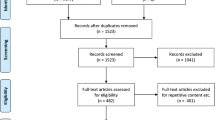Abstract
In May 2005, a multidetector computed tomography (CT) scanner was installed into the mortuary of the Victorian Institute of Forensic Medicine (VIFM). Since that time most biological material admitted to the institute has been scanned. This article provides an overview of the experience gained and difficulties encountered by participants in this project. Discussion is presented on the incorporation of routine CT imaging into autopsy procedures, application of CT in forensic research, and how we believe the use of cross-sectional imaging will evolve in forensic investigation of the deceased.

Similar content being viewed by others
References
Donchin Y, Rivkind AI, Bar-Ziv J, Hiss J, Almog J, Drescher M. Utility of post-mortem computed tomography in trauma victims. J Trauma 1994;37:552–5.
Oliver WR, Chancellor AS, Soltys M, Symon J, Cullip T, Rosenman J, Hellman R, Boxwala A, Gormley W. Three dimensional reconstruction of a bullet path: validation by computed radiography. J Forensic Sci 1995;40:321–4.
Farkash U, Scope A, Lynn M, Kugel C, Maor R, Abargel A, Eldad A. Preliminary experience with post-mortem computed tomography in military penetrating trauma. J Trauma 2000;48:303–8.
Thali MJ, Schweitzer W, Yen K, Vock P, Ozdoba C, Spielvogel E, Dirnhofer R. New horizons in forensic radiology: the 60-second “digital autopsy”; Full-body examination of a gunshot victim by multi-slice computed tomography. Am J Forensic Med Pathol 2003;24:22–7.
Thali MJ, Yen K, Schweitzer W, Vock P, Boesch C, Ozdoba C, Schroth G, Ith M, Sonnenschein M, Doernhofer T, Scheurer E, Plattner T, Dirnhofer R. Virtopsy, a new imaging horizon in forensic pathology: virtual autopsy by post-mortem multislice computed tomography (MSCT) and magnetic resonance imaging (MRI)—a feasibility study. J Forensic Sci 2003;48:386–403.
Yen K, Vock P, Tiefenthaler B, Ranner G, Scheurer E, Thali MJ, Zwygart K, Sonnenschein M, Wiltgen M, Dirnhofer R. Virtopsy: Forensic Traumatology of the subcutaneous fatty tissue; Multislice computed tomography (MSCT) and magnetic resonance imaging (MRI) as diagnostic tools. J Forensic Sci 2004;49:799–806.
Thali MJ, Braun M, Buck U, Aghayev E, Jackowski C, Vock P, Sonnenschein M, Dirnhofer R. Virtopsy—scientific documentation, reconstruction and animation in forensic: individual and real 3D data based geometric approach including optical body/object surface and radiological CT/MRI scanning. J Forensic Sci 2005;50:428–42.
Jackowski C, Thali MJ, Aghayev E, Yen K, Sonnenschein M, Vock P, Dirnhofer R. Non-invasive estimation of organ weights by post-mortem magnetic resonance imaging and multislice computed tomography. Invest Radiol 2006;41:572–8.
Thali MJ, Markwalder T, Jackowski C, Sonnenschein M, Dirnhofer R. Dental CT imaging as a screening tool for dental profiling: advantages and limitations. J Forensic Sci 2006;51:113–9.
Poulsen K, Simonsen J. Computed tomography as routine in connection with medico-legal autopsies. Forensic Sci Int 2006. doi:10.1016/j.forsciint.2006.05.041 (article in press).
Hayakawa M, Yamamoto S, Motani H, Yajima D, Sato Y, Iwase H. Does imaging technology overcome problems of conventional post-mortem examination? A trial of computed tomography imaging for post-mortem examination. Int J Legal Med 2006;120:24–6.
Jackowski C, Sonnenschein M, Thali MJ, Aghayev E, Yen K, Dirnhofer R, Vock P. Intrahepatic gas at post-mortem computed tomography: forensic experience as a potential guide for in vivo trauma imaging. J Trauma 2007 62(4):979–88.
Rutty GN, Swift B. Accuracy of magnetic resonance imaging in determining cause of sudden death in adults: comparison with conventional autopsy. Histopathology. 2004;44(2):187–9 (letter).
Davis GJ, Peterson BR. Dilemmas and solutions for the pathologist and clinician encountering religious views of the autopsy. South Med J 1996;89:1041–4.
Bahadori M. ‘Post-mortem examination in Iran: autopsy in culture with some restriction on autopsies,’ in Symposium 11: the state and use of the autopsy around the world. Histopathology 2002;41 Suppl 2:197–213.
Sidler M, Jackowski C, Dirnhofer R, Vock P, Thali MJ. Use of multislice computed tomography in disaster victim identification—advantages and limitations. Forensic Sci Int 2006. doi:10.1016/j.forsciint.2006.08.004 (article in press).
Levy AD, Abbot RM, Mallak CT, Getz JM, Harcke HT, Champion HR, Pearse LA. Virtual autopsy: preliminary experience in high-velocity gunshot wound victims. Radiology 2006;240:522–8.
Thali MJ, Yen K, Vock P, Ozdoba C, Kneubuehl BP, Sonnenschein M, Dirnhofer R. Image-guided virtual autopsy findings of gunshot victims performed with multi-slice computed tomography (MSCT) and magnetic resonance imaging (MRI) and subsequent correlation between radiology and autopsy findings. Forensic Sci Int 2003;138:8–16.
Aghayev E, Sonnenschein M, Jackowski C, Thali M, Buck U, Yen K, Bolliger S, Dirnhofer R, Vock P. Post-mortem radiology of fatal hemorrhage: measurements of cross-sectional areas of major blood vessels and volumes of aorta and spleen on MDCT and volumes of heart chambers on MRI. AJR Am J Roentgenol 2006 187(1):209–15.
Yen K, Lovblad KO, Scheurer E, Ozdoba C, Thali MJ, Aghayev E, Jackowski C, Anon J, Frickey N, Zwygart K, Weis J, Dirnhofer R. Post-mortem forensic neuroimaging: correlation of MSCT and MRI findings with autopsy results. Forensic Sci Int 2007 Feb 27; [Epub ahead of print].
Dirnhofer R, Jackowski C, Vock P, Potter K, Thali MJ. Virtopsy: Minimally invasive, imaging-guided virtual autopsy. Radiographics 2006;26:1305–33.
Aghayev E, Thali MJ, Sonnenschein M, Jackowski C, Dirnhofer R, Vock P. Post-mortem tissue sampling using computed tomography guidance. Forensic Sci Int 2007;166:199–203.
Thali MJ, Jackowski C, Oesterhelweg L, Ross SG, Dirnhofer R. VIRTOPSY—The Swiss virtual autopsy approach. Leg Med (Tokyo) 2007;9(2):100–4. Epub 2007 Feb 1.
Author information
Authors and Affiliations
Corresponding author
Rights and permissions
About this article
Cite this article
O’Donnell, C., Rotman, A., Collett, S. et al. Current status of routine post-mortem CT in Melbourne, Australia. Forensic Sci Med Pathol 3, 226–232 (2007). https://doi.org/10.1007/s12024-007-9006-8
Accepted:
Published:
Issue Date:
DOI: https://doi.org/10.1007/s12024-007-9006-8




